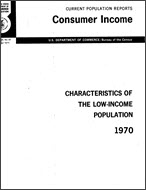Characteristics of the Low-Income Population: 1970
Characteristics of the Low-Income Population: 1970
This report presents social and economic statistics for the population of the United States below the low-income level/1 in 1970, based on ·the March 1971 Current Population Survey. The detailed tables include data on geographic distribution; race and ethnic origin, family status, size of family, education, employment status, work experience, occupation, income (including type and source), and income deficit. Where available, data are presented for whites and Negroes separately. Though the majority of the detailed tables pertain to families and unrelated individuals, selected tables are also presented for persons. A description of the low-income population in 1970 and some analysis of changes in the composition of the low-income population over the past year and since 1959 are included.
This is the third Census Bureau report to present detailed data based on the poverty definition adopted as the official government standard in 1969 (see Definitions and Explanations, page 19, for a detailed description of this definition). The tables presented in this report are similar to those found in Current Population Reports, Series P-60, No. 76, "24 MILLION AMERICANS—Poverty in the United States: 1969," though several new items such as data on ethnic origin and labor union membership have been added. The tables found in the first report presenting detailed data for the low-income population, Current Population Reports, Series P-60, No. 68, "Poverty in the United States: 1959 to 1968," are less comprehensive than those found in this report or in P-60, No. 76, since they were presented for a 10-year period. The table on page III provides a comparison between the tables contained in this report and corresponding data for previous years presented in the two reports mentioned above.
__________
/1 Families and unrelated individuals are classified as being above or below the low-income level, using the poverty index adopted by a Federal Interagency Committee in 1969. This index is based on a sliding scale of income, adjusted for such factors as family size, sex and age of the family head, the number of children, and farm-nonfarm residence. In order to keep the poverty standard constant over time, the thresholds are updated annually based on changes in the Consumer Price Index. The low-income threshold for a nonfarm family of four was $3,968 in 1970, $3,743 in 1969, and $2,973 in 1959. See page 19 for a detailed description of the poverty definition used in this report. In the text of this report, the terms "poverty" and "low-income" are used interchangeably.
A Note on Language
Census statistics date back to 1790 and reflect the growth and change of the United States. Past census reports contain some terms that today’s readers may consider obsolete and inappropriate. As part of our goal to be open and transparent with the public, we are improving access to all Census Bureau original publications and statistics, which serve as a guide to the nation's history.
Related Information
-
Publication24 Million Americans—Poverty in the United States: 1969This report presents statistics on poverty in the United States in 1969, including such characteristics as race, size of family, employment status, and income.
-
PublicationPoverty in the United States: 1959 to 1968This report presents data from 1959 and 1968 on persons and families below the poverty level.
Others in Series
Publication
Publication
Publication




